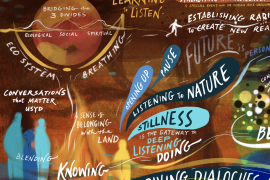I heard someone say of their students recently that, “you cannot show them weakness or they’ll exploit it.” I’m certainly familiar with this attitude. Some version of it was my own in my early years of teaching as a young woman in a department where the faculty, graduate and undergraduate populations skewed male, and where aggressive norms of argumentation were de rigueur.
Over the years, however, some combination of exhaustion at maintaining this posture – helped along by a few episodes of vertigo in class or running out to vomit – and the desire to connect authentically with students brought an end to this teaching persona.
I reported this teacher exploitation hypothesis to students in week 1 this year as a basis for how I’m not going to approach our class. I let students know that their experience of our class was important to me and that, if they had requests, I would believe their reasons. In return, I expected students to be honest and earnest in their engagement, and show me kindness in return. One specific request I made of students is that they respect my working hours and not make time-sensitive requests outside of those unless there was an emergency. Sharing these thoughts was also in partial explanation of why I was prioritising students’ comfort over getting through the course material I had prepared for our class. For context, our classroom air-conditioner was broken (reading at a sweltering 30 degrees!), and we were outside on the floor approaching our material conversationally. We also wrapped up early.
it involves showing up, listening to and believing our students
Over the summer, I learned a name for the teaching and learning philosophy that had clearly underpinned my practice: a pedagogy of kindness. According to practitioners, a pedagogy of kindness involves “believing students and believing in them” (Denial 2019; 2024). While this might not be a particularly satisfying definition of kindness, it certainly captures one of the features that kindness entails. Put simply, it involves showing up, listening to and believing our students (Payne and Clemons, 2024). In a context where students report low feelings of belonging to their institutions of higher education, being present and listening may well be a transformative act of kindness.
To be sure, kindness isn’t simply being nice and agreeable. Indeed, being kind can often mean being the exact opposite of agreeable. It’s easy to imagine moments where kindness means being honest with a student, for example, by providing feedback that challenges or upsets them. Kindness can mean having the hard conversations, not just the ones that make you seem likeable to your students.
There are reasonable questions one might raise about the pedagogy of kindness. For example, aren’t we just describing good teaching? In an article from the 2010s, Clegg and Rowland write that their goal was to “elucidate a quality that is already there in good teaching, but is unremarked and under threat in the contemporary conditions of higher education” (2010, 720). At the time, measures of teacher excellence provided by professional organisations such as the UK’s AdvanceHE omitted reference to kindness despite it being an often remarked-upon quality that is prized by students. (It’s not clear that it’s been incorporated into recent revisions to the AdvanceHE Professional Standards Framework). We can only hope that one way of defining “supporting and guiding learners” in our own Academic Excellence Framework at Sydney enables us to express the relational care we provide students, both as part of our routine work and in the supererogatory ways we help students all of the time.
According to practitioners, a pedagogy of kindness involves “believing students and believing in them”
One worry we might have is that this requires (additional) emotional labour, labour that routinely falls to female colleagues and colleagues from underrepresented groups (Clegg and Rowland 2010; Denial 2024). Yet one can argue that if the pedagogy of kindness was widespread, the burden of attending to students who otherwise believe they do not belong or feel heard would not be so great on those of our colleagues who are more approachable. Arguably there’s a separate but important question to be raised about who students typically expect to be kind and how we might break down the stereotypes that inform these beliefs.
Practitioners believe that a pedagogy of kindness “can pave the way for a more inclusive, just and compassionate educational landscape” for all (Grant and Pittaway 2024, 6). Kindness is not only directed towards students, therefore; it is something we should direct towards ourselves as educators, and something we should expect from our institution. Establishing strong emotional boundaries with students is therefore compatible with a pedagogy of kindness, not something we must sacrifice at the altar of student demand. As Denial puts it in her recent book, “[b]oundaries, too, are a form of kindness, a way of honoring our physical and mental energy so that we do not deplete ourselves in the service of others” (2024). More than this, kindness ought to inform institutional expectations about the work we routinely, but often invisibly, undertake. In this way, scholars of the pedagogy of kindness believe their work presents an opportunity to transform institutions of higher education.
If, as our students might say, this is your vibe, here are some starting reflections for implementing a pedagogy of kindness:
- How do we position our students through our teaching? What is the text and subtext of how we relate to students and how we describe their learning to them? (Denial, 2024).
- A pedagogy of kindness involves creating a just teaching, learning, and institutional environment. For Denial, teaching with kindness requires us to reflect on who is in our classroom, why they are there, and what obstacles they face in their learning and our classroom.
- Kindness in the classroom begins with kindness towards ourselves as members of our institutions. For Denial “self care… is far from the act of buying a nail polish or sipping a glass of wine…[it’s] a profoundly political act” (2024).





